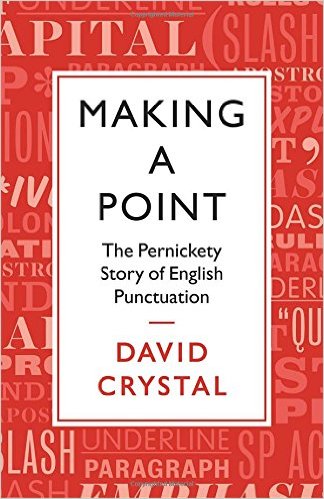(Released October 2015)
By Nicole North

This latest book by world-renowned linguistics authority David Crystal showcases his talent for instructing writers of English while entertaining them with great wit and a punchy narrative style. Punctuation is the focus of Making a Point, and Crystal gives a detailed and straightforward history of its use as well as effective advice.
For Crystal, punctuation is about improving legibility, avoiding ambiguity, reflecting the natural rhythms of speech, and clarifying complex sentences. Editors and writers of all sorts will find this book helpful. Crystal uses examples from an impressive array of works—short stories, poetry, novels, essays, advertisements, and emoji-laden text.
Each example illustrates topics pertinent not only to specific genres of writing but also to greater points about today’s uses of punctuation. This study of punctuation as a window into linguistics in general and effective communication in particular elucidates a key aspect of writing and editing.
One strong chapter explains the role of the semicolon as “to unite and divide at the same time.” This mark elicits strong opinions, such as Kurt Vonnegut’s contention that semicolons are “transvestite hermaphrodites representing absolutely nothing. All they do is show you’ve been to college.” An offensive and hastily dismissed characterization indeed, yet it is true that the semicolon is often underrated. Crystal values the semicolon for providing a necessary rung on the punctuation ladder below the period and above the comma. He uses excerpts from Bleak House to illustrate how the semicolon can be indispensable in creating atmosphere through detailed description. Other helpful tips involve using semicolons to clarify the separation of pairs of sentences (rather than just individual sentences) and in organizing lists containing multiple either/or scenarios.
On the whole, Crystal’s choices of historical and contemporary anecdotes are edifying as well as fun to read. Bygone marks such as the percontation mark, used to convey that a question is rhetorical, have fascinating stories to tell. A handful of these anecdotes, however, fall a bit short. The use of the hyphen is covered extensively in this book and largely to great effect, but there is a bit of exaggeration regarding the controversy over minute aspects of its changing role over time and across different regions; the decision in 2013 by artist Jay Z to drop the hyphen from his name made perhaps a lesser impact than Crystal emphasizes.
One punctuation mark that is widely controversial is the exclamation point. Many editors and writers utterly revile the exclamation point, while others insist that it is necessary for clear expression. Crystal acknowledges that the mark is understandably ubiquitous in some areas of writing, such as advertising, pop autobiography, children’s fiction, and blog posts. An exclamation point conveys heightened emotion like nothing else can. Yet many argue that within certain genres of writing, such as formal essays, news publications, and traditional-format poetry, there is no place for the overeager and crass nature of the exclamation point. Crystal’s chapter on this mark offers several solutions for effectively incorporating it into pieces of writing to express interjections, expletives, commands, greetings, surprise, anger, irony, or some combination thereof.
The visual effect created by punctuation choices can help editors make style decisions for publications where the visual experience is significant. Within the text of Making a Point itself, when deciding between using either em dashes or “space-en-space dashes,” Crystal chose the latter because of their “cleaner-looking” appeal. Crystal offers the idea that with certain style decisions, being overly fixated on dogmatic systems of punctuation makes us too rigid in our edits. He dubs this the “ugly face of prescriptivism.” Decisions such as whether to include or omit the serial comma can simply be made according to the needs of the publication, the writer’s unique voice, and personal preference where appropriate. The inclusion or avoidance of parentheses is a similar case, in that the decision is a question of consistency and style rather than of correctness.
The most practical and beneficial aspect of Crystal’s approach is his overarching advice that, as editors, we allow our ears and our honed instincts to guide punctuation choices. The natural rhythms of speech, the pauses and the parallels inherent in common-use language, are there to shape how we punctuate. Crystal has provided a detailed, lively, and clever account of how we can use diversity in punctuation to improve any piece of writing.
Nicole North is a freelancer specializing in writing and substantive, line, and copy editing. She volunteers frequently for Editors Canada.
This article was copy edited by Christine Albert.
